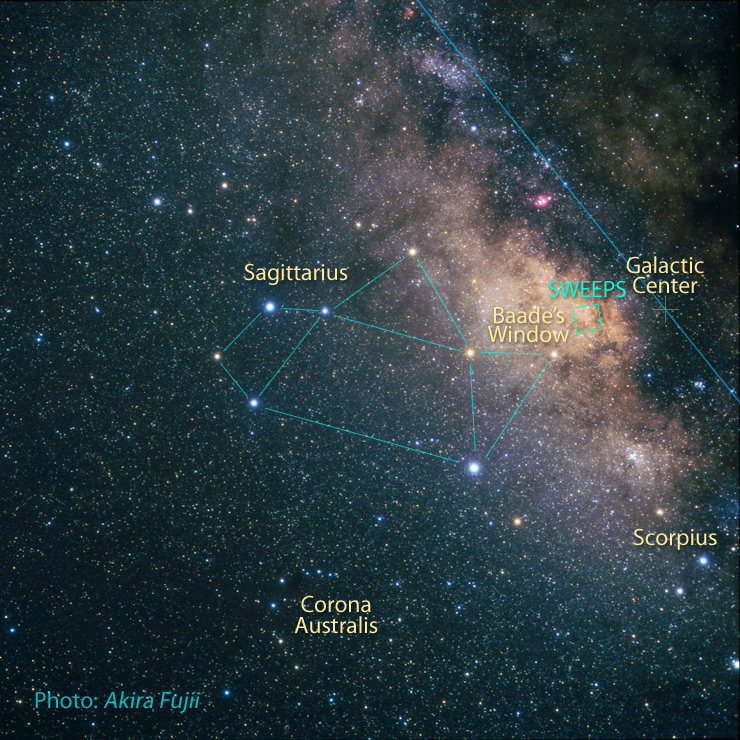Sagittarius Window Eclipsing Extrasolar Planet Search on:
[Wikipedia]
[Google]
[Amazon]
The Sagittarius Window Eclipsing Extrasolar Planet Search, or SWEEPS, was a 2006

 The stars that were monitored in this
The stars that were monitored in this
News Release Number: STScI-2006-34 Hubble Finds Extrasolar Planets Far Across Galaxy
{{Portal bar, Astronomy, Stars, Spaceflight, Outer space, Solar System Sagittarius (constellation) Astronomical surveys Exoplanet search projects Hubble Space Telescope
astronomical survey
An astronomical survey is a general map or image of a region of the sky (or of the whole sky) that lacks a specific observational target. Alternatively, an astronomical survey may comprise a set of images, spectra, or other observations of ob ...
project using the Hubble Space Telescope
The Hubble Space Telescope (often referred to as HST or Hubble) is a space telescope that was launched into low Earth orbit in 1990 and remains in operation. It was not the first space telescope, but it is one of the largest and most ver ...
's Advanced Camera for Surveys - Wide Field Channel to monitor 180,000 stars for seven days to detect extrasolar planet
An exoplanet or extrasolar planet is a planet outside the Solar System. The first possible evidence of an exoplanet was noted in 1917 but was not recognized as such. The first confirmation of detection occurred in 1992. A different planet, init ...
s via the transit method
Any planet is an extremely faint light source compared to its parent star. For example, a star like the Sun is about a billion times as bright as the reflected light from any of the planets orbiting it. In addition to the intrinsic difficulty o ...
.
Area examined

 The stars that were monitored in this
The stars that were monitored in this astronomical survey
An astronomical survey is a general map or image of a region of the sky (or of the whole sky) that lacks a specific observational target. Alternatively, an astronomical survey may comprise a set of images, spectra, or other observations of ob ...
were all located in the Sagittarius-I Window. The Sagittarius Window is a rare view to the Milky Way
The Milky Way is the galaxy that includes our Solar System, with the name describing the galaxy's appearance from Earth: a hazy band of light seen in the night sky formed from stars that cannot be individually distinguished by the naked ey ...
's central bulge stars: our view to most of the galaxy's central stars is generally blocked by lanes of dust. These stars in the galaxy's central bulge region are approximately 27,000 light year
A light-year, alternatively spelled light year, is a large unit of length used to express astronomical distances and is equivalent to about 9.46 trillion kilometers (), or 5.88 trillion miles ().One trillion here is taken to be 1012 ...
s from Earth.
Planets discovered
Sixteen candidate planets were discovered with orbital periods ranging from 0.6 to 4.2day
A day is the time period of a full rotation of the Earth with respect to the Sun. On average, this is 24 hours, 1440 minutes, or 86,400 seconds. In everyday life, the word "day" often refers to a solar day, which is the length between two s ...
s. Planets with orbital periods less than 1.2 days have not previously been detected, and have been dubbed "ultra-short period planet
An ultra-short period (USP) planet is a type of exoplanet with orbital period less than one day. At this short distance, tidal interactions lead to relatively rapid orbital and spin evolution. Therefore when there is a USP planet around a mature ...
s" (USPPs) by the search team. USPPs were discovered only around low-mass stars, suggesting that larger stars destroyed any planets orbiting so closely or that planets were unable to migrate as far inward around larger stars.
Planets were found with roughly the same frequency of occurrence as in the local neighborhood of Earth.
SWEEPS-4 and SWEEPS-11 orbited stars that were sufficiently visually distinct from their neighbors that follow-up observations using the radial velocity method
Doppler spectroscopy (also known as the radial-velocity method, or colloquially, the wobble method) is an indirect method for finding extrasolar planets and brown dwarfs from radial-velocity measurements via observation of Doppler shifts in ...
were possible, allowing their masses to be determined.
This table is constructed from information obtained from the Extrasolar Planets Encyclopedia and SIMBAD
SIMBAD (the Set of Identifications, Measurements and Bibliography for Astronomical Data) is an astronomical database of objects beyond the Solar System. It is maintained by the Centre de données astronomiques de Strasbourg (CDS), France.
SIMB ...
databases that reference the ''Nature'' article as their source.
See also
* Baade's Window *Optical Gravitational Lensing Experiment
The Optical Gravitational Lensing Experiment (OGLE) is a Polish astronomical project based at the University of Warsaw that runs a long-term variability sky survey (1992–present). The main goals are the detection and classification of variable ...
or ''OGLE'' also examines the galactic bulge
In astronomy, a galactic bulge (or simply bulge) is a tightly packed group of stars within a larger star formation. The term almost exclusively refers to the central group of stars found in most spiral galaxies (see galactic spheroid). Bulges ...
for planets.
References
External links
News Release Number: STScI-2006-34 Hubble Finds Extrasolar Planets Far Across Galaxy
{{Portal bar, Astronomy, Stars, Spaceflight, Outer space, Solar System Sagittarius (constellation) Astronomical surveys Exoplanet search projects Hubble Space Telescope